Quick Wrap Bags For Drawings
Poly Bags
Introduction
This article takes an in-depth look at Poly Bags.
You will learn about topics such as:
- What is a poly bag?
- How poly bags are made
- Uses for poly bags
- Types of poly bag materials
- And much more …
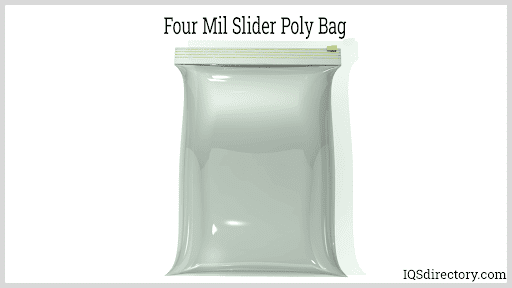
Chapter 1: What is a Poly Bag??
A poly bag is a common shipping and packaging resource made of polymer material that is exceptionally durable, pliable, and customizable to fit any application. Made of polyethylene or polystyrene materials, poly bags are a precisely engineered and designed compact method for protecting and securing products, parts, and merchandise.
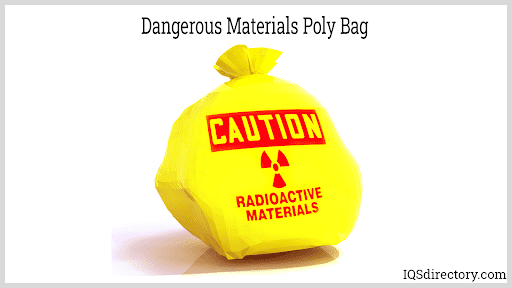
Though polyethylene was introduced during the first industrial revolution, it wasn't until the 1950s that it was turned into the poly bags we see today. The growing popularity of poly bags is due to the need for an inexpensive, sturdy, and useful method of transporting goods safely and securely.
Chapter 2: How Poly Bags are Made
The production of poly bags involves highly technical and scientifically engineered processes that are precisely planned to ensure high quality results. All forms of poly bags begin with high resin plastic pellets that produce the required type of film and gauge.
All poly producers rely on the heating and extruding of the resin pellets, which are made from ethylene or propylene that is taken from crude oil. In ethylene and propylene are hydrocarbons that are used to make monomers from a cracking process. From the monomers comes the polymerization reaction to produce polymer resins for the manufacture of poly bags.
How Poly Bags are Made
Resin or Plastic Pellets
The type of resin selected for the manufacture of a poly bag determines the durability, weight, and thickness of the bag. There are five types of resins used to produce plastic bags: high density polyethylene (HDPE), low density polyethylene (LDPE), linear low density polyethylene (LLDPE), medium density polyethylene (MDPE), and polypropylene (PP). The characteristics and properties of these polymers are the major factors regarding a bag's strength and life expectancy.
The creation and manufacture of high quality poly bags begins with the selection of the correct bag materials.
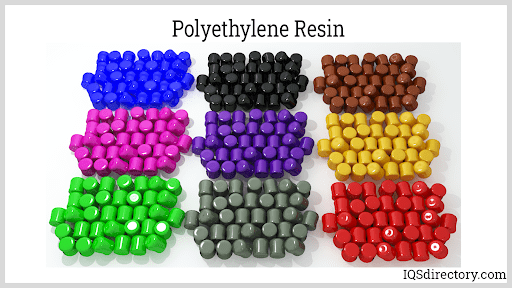
Extrusion
Once the resin has been selected, it is loaded into the hopper of an extruder. The initial method for melting plastic pellets was to simply heat them in a vat or large barrel. The result was an uneven heating of the material with pellets closest to the heat source being hotter and more pliable.
This led to the development of the extruder, a screw mechanism that evenly heats the material at 350° F to 450° F such that all of the pellets are melted to the same temperature. An extruder is screw-like with a loading hopper at one end and a die at the other. The resin is fed into the hopper, which slowly drops the resin into the barrel of the extruder. As the screw turns, the pellets move along the length of the extruder, heated by heating units placed along the length of the barrel.
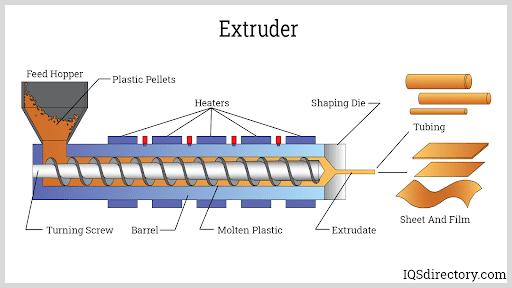
Inflation
The molten plastic resin exits the extruder die in the shape of a tube and is inflated and stretched to the needed size and shape of the poly bag.
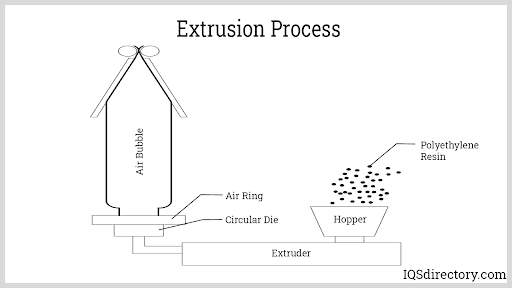
Cooling Tower
Once the tube of plastic is fully extended, it remains in the tower until it cools. In the cooling tower, it has the appearance of a tall plastic vertical balloon. As it expands upward, it comes into contact with the walls of the tower and cools as it works its way up to the cutting rollers.
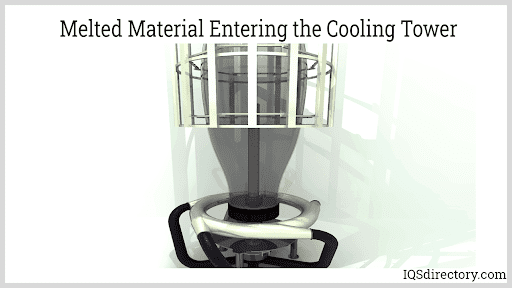
Nip Rollers
To make the plastic fabric, the tube passes through the collapsing frame before entering the nip rollers that flatten it into a lay flat form to be rolled into a large roll of plastic. Nip rollers provide high traction, isolate web tension zones, and improve winding onto a roller.
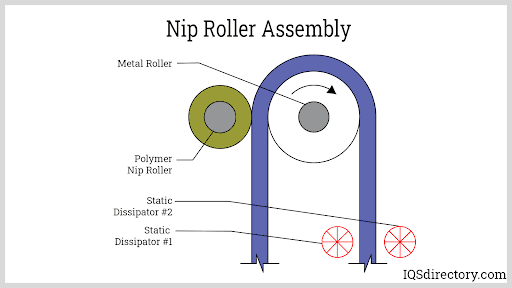
Rolling Film
Once the inflated film is flattened and passes through the collapsing frame and nip rollers, it is rolled into a huge roll for processing. It is from these rolls that the poly bags will be printed, formed, cut to lengths, and sealed.
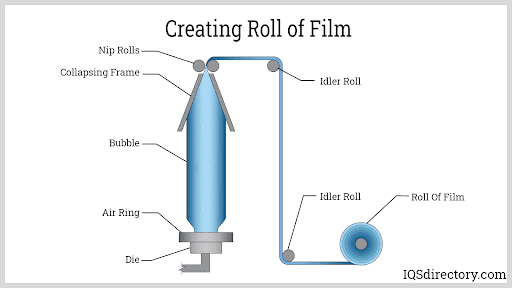
Flexographic Printing
Poly bags come in different sizes, thicknesses, colors, and forms. Bags that are produced for stores, shops, and retail outlets usually have print identifying the store with some of the printing offering additional information. Printing on poly bags is done by a process known as flexography, a roll feed web printing process used to print on film, foils, paper, cardboard, and other materials.
The image to be transferred is imprinted on a polymer plate using ultraviolet light. The image is engineered and designed on a computer using design software such as CAD. The negative of the image is placed on a light sensitive polymer plate. When it is exposed to ultraviolet light, the image hardens while the material around it turns to a gummy substance that is washed away.
The completed plate is wrapped around a cylinder. As the poly material passes between two cylinders, one with the plate on it, the plate is wetted with ink and prints the image on the bags. For single color printing, one plate and set of cylinders are used. When multiple colors are necessary, the poly bags will pass through a series of cylinders, each having a different portion of the image.
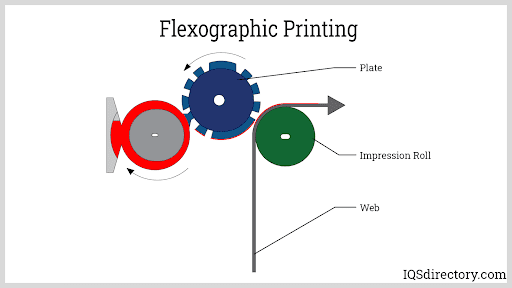
Cutting
During the printing process, the roll of film from the extruding and blowing process is unrolled as it passes through the flexographic printer. After the poly bags are printed, they are re-rolled in preparation for the cutting process.
Every manufacturer has their unique process for cutting poly bags, which includes the sealing of the bag. Handles may be cut and shaped in addition to cutting the bag to length.
Additionally, the cutting process has to allow for gussets that may have been added during the cooling of the plastic tube after extrusion.
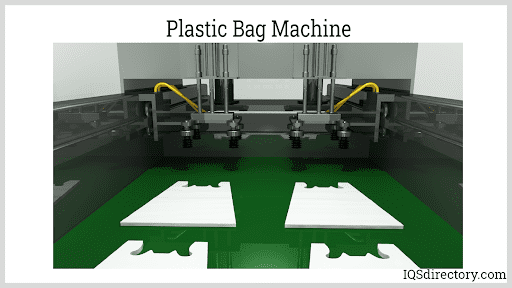
Poly Bag Production
Though numbers vary, poly bag producers can process as many as 70,000 bags an hour, depending on the size, type of polymer, and length of the bag. Larger and longer bags are produced at 2,000 bags per hour.
Hourly production of poly bags is dependent on the size of the bag and the thickness of the polymer, which is significantly altered by thicker, longer, heavier bags.
GET YOUR COMPANY LISTED BELOW
Leading Manufacturers and Suppliers
Chapter 3: Uses for Poly Bags
The many options and designs for plastic bags has made them an essential part of society. Poly bags have become so common that they are taken for granted as a means for packaging, shipping, and handling a wide array of products. Though poly bags have a very basic function as a tool for transporting goods, their use has expanded far beyond their original purpose.
When poly bags were first introduced as a way to package a customer's purchases, they were clear or plain white. Once it was obvious that poly bags would be common, marketers saw an opportunity to expand the use of the bags as a means for making a company's or product's logo visible, which led to the printing of information on the sides of the bags.
Uses for Poly Bags
Pallet Bags
Pallet poly bags help to keep materials on a pallet and protect them from the elements. They are ideal for shipping purposes for equipment, machinery, products, and inventory supplies. A major feature of pallet bags is their ability to expand to snuggly fit any type of pallet load.
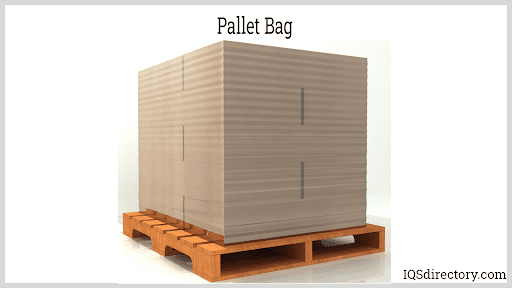
Food Bags
Poly food bags have been on the market for many years as a means of protecting the quality and cleanliness of food. The various types of poly food bags keep moisture, air, and atmospheric contaminants away from displayed food products. The many designs include those that can be vacuum sealed such that air is removed from the interior of the bag, enhancing its protective qualities.
In order for a poly bag to be classified as a food service or storage bag, it is required to meet the standards established by the Food and Drug Administration (FDA) as well as those of the United States Department of Agriculture (USDA). Poly bags that have met the requirements have indications stamped on the bag.
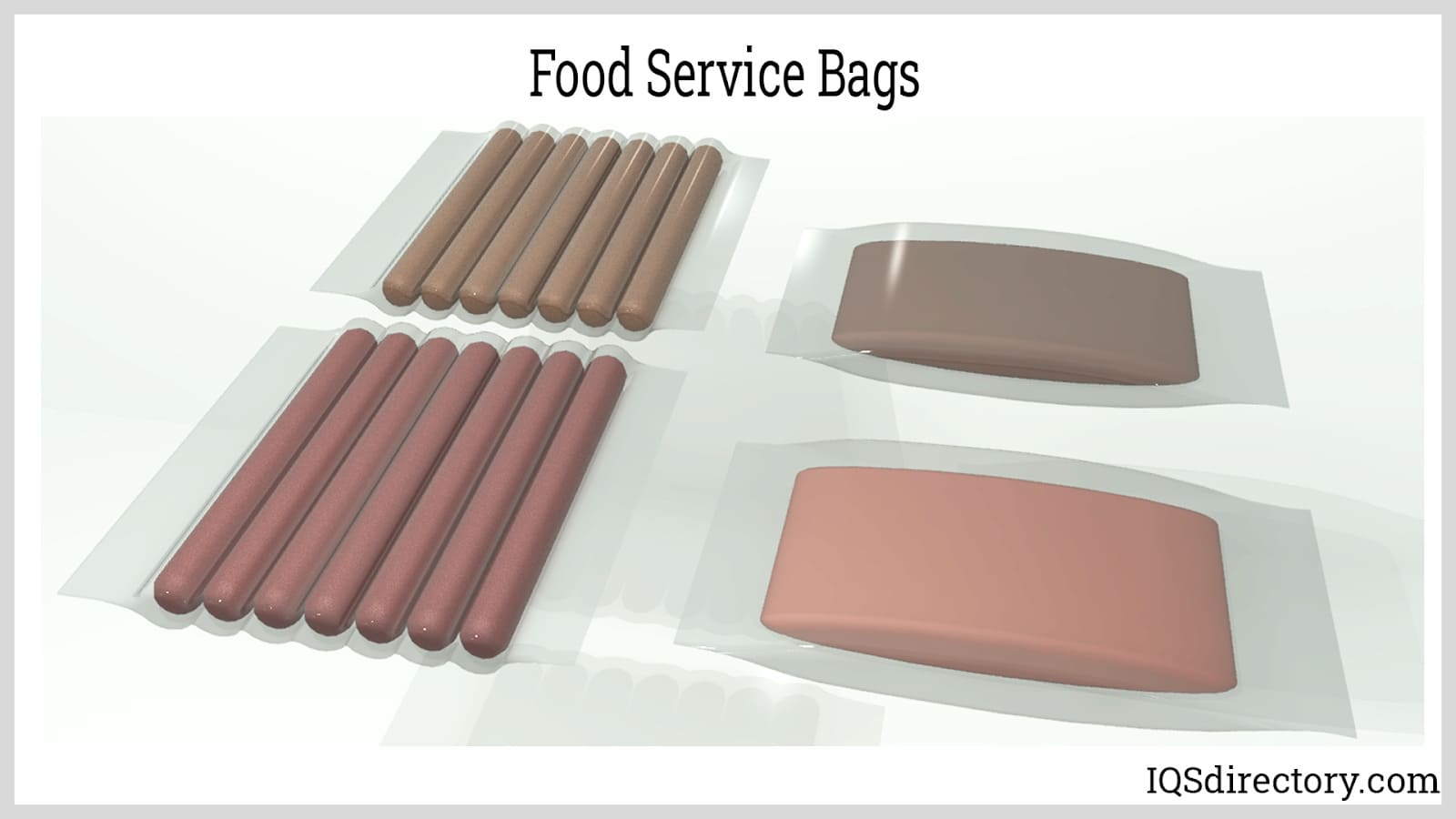
Box Liners
Box liners are designed to keep products and supplies clean, safe, and protected. They serve the same purpose as pallet bags by providing durable protection when materials and items are in storage. High density polyethylene liners have excellent strength and durability and are available in several sizes to fit any box.
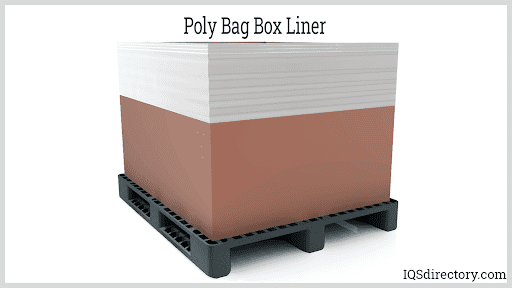
Trash Bags
Poly trash bags have become a more common household item, available in sizes to fit any type of trash can, from large bags for yard waste to small bags for office trash cans. Many waste management companies require their customers to put their non-recyclable trash in heavy duty trash bags. Possible trash bags selections include those that have odor suppressors, draw strings of varying types, and handles. The various innovative designs have greatly enhanced the trash collection industry.
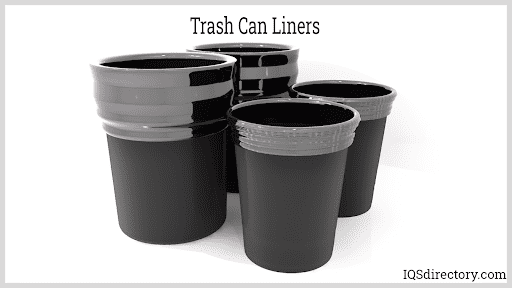
Poly Anti-Static Bags
Poly anti-static bags minimize static electricity and protect against damage from electrostatic discharge (ESD). They are designed for the storage and packaging of electronic components that may be damaged by environmental ESDs. Manufacturers offer various forms of poly anti-static bags, which are air tight for water protection and contain fire retardant material.
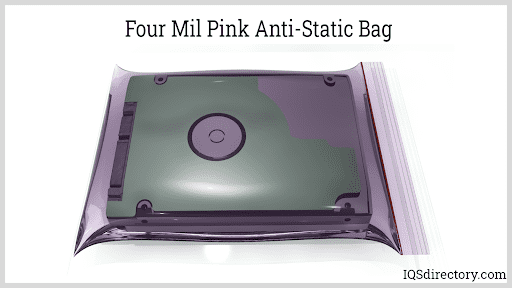
Mailer Bags
Mailer or shipping bags are used for shipping products and avoiding the weight of boxes. There are several varieties of mailer bags, including those with a zip closure, pressure closure, and peel and seal. The seal on mailer bags protects shipped products from environmental contaminants and the weather. Some companies use mailer bags as a way to display their logo and offer brand visibility.
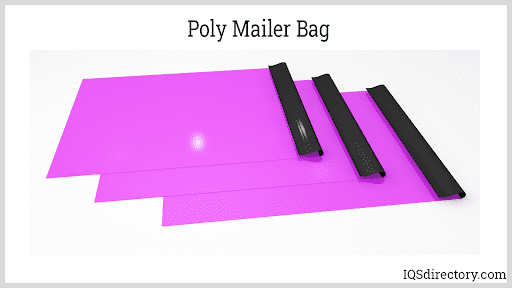
Zipper Bags
Zipper bags are one of the most used bags on the market due to their toughness and durability. They are available in a wide range of sizes for simple shelf storage or freezer storage. The unique features of zipper bags are their tight zip seal, sturdy secure edges, and ability to be reused. Zipper bags are used in homes and manufacturing as a secure and guaranteed means of protecting stored materials.
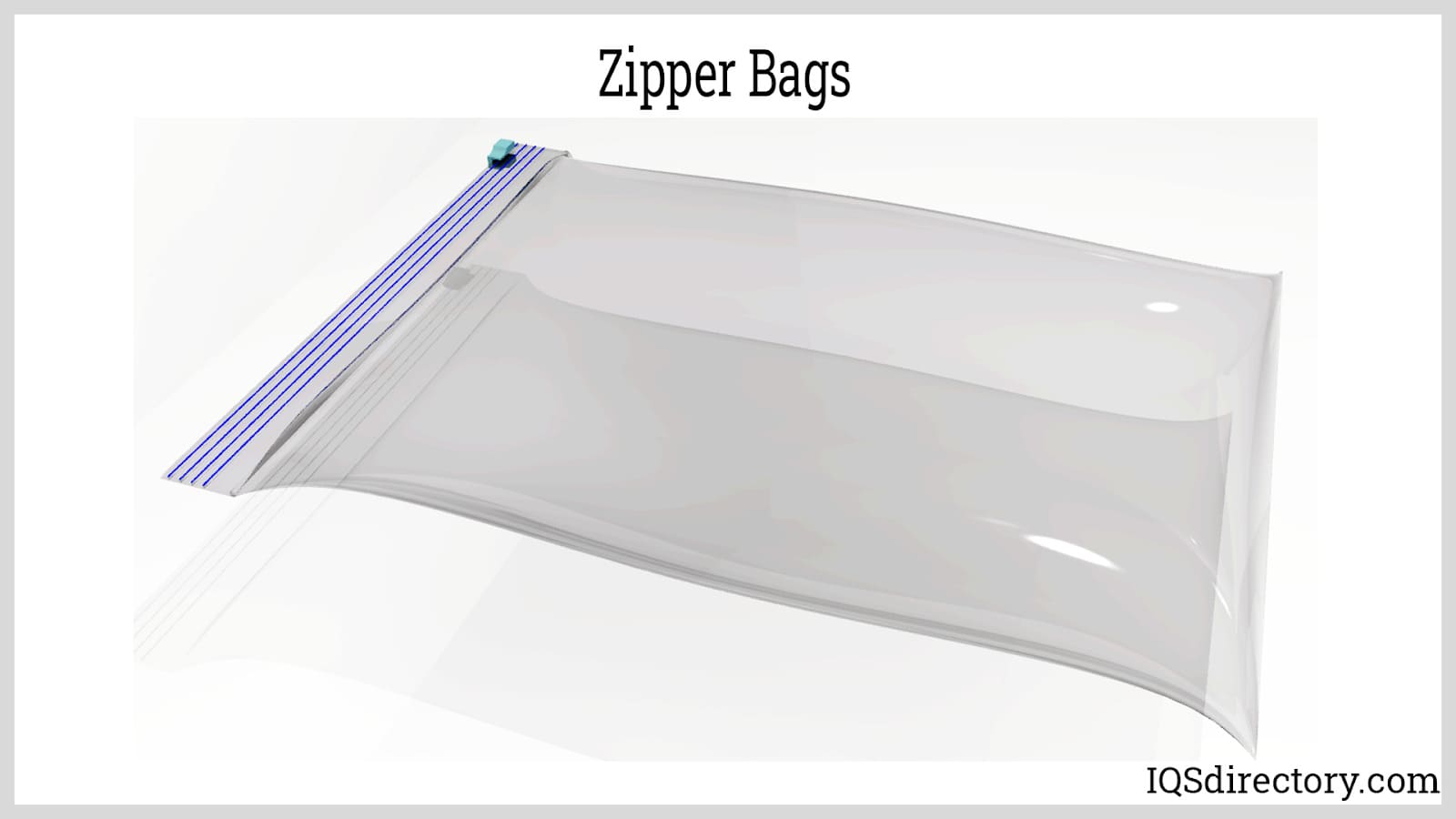
Gusseted Bags
Gussets are additions to bags that allow them to expand and provide more room. They are added during the extruding process as the bag cools on the sides of the blow tube. The purpose of gussets is to increase the volume of the bag and add to its capacity. They can be added to any size bag but are generally found in shopping and shipping bags for ease of packing.
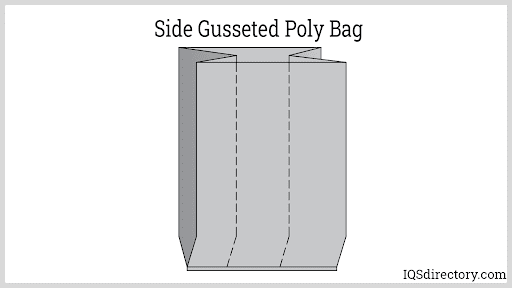
Header Bags
Header bags are display bags with brand information at the top and a bag attached underneath for the product. They are clear poly bags such that the item on display can be easily seen but securely sealed at the top to prevent tampering. In most cases, header bags have a hole in the header such that they can be hung on a display rack. The printed, sealed top removes the need for a cardboard or paper attachment, which significantly reduces the cost of the bag.
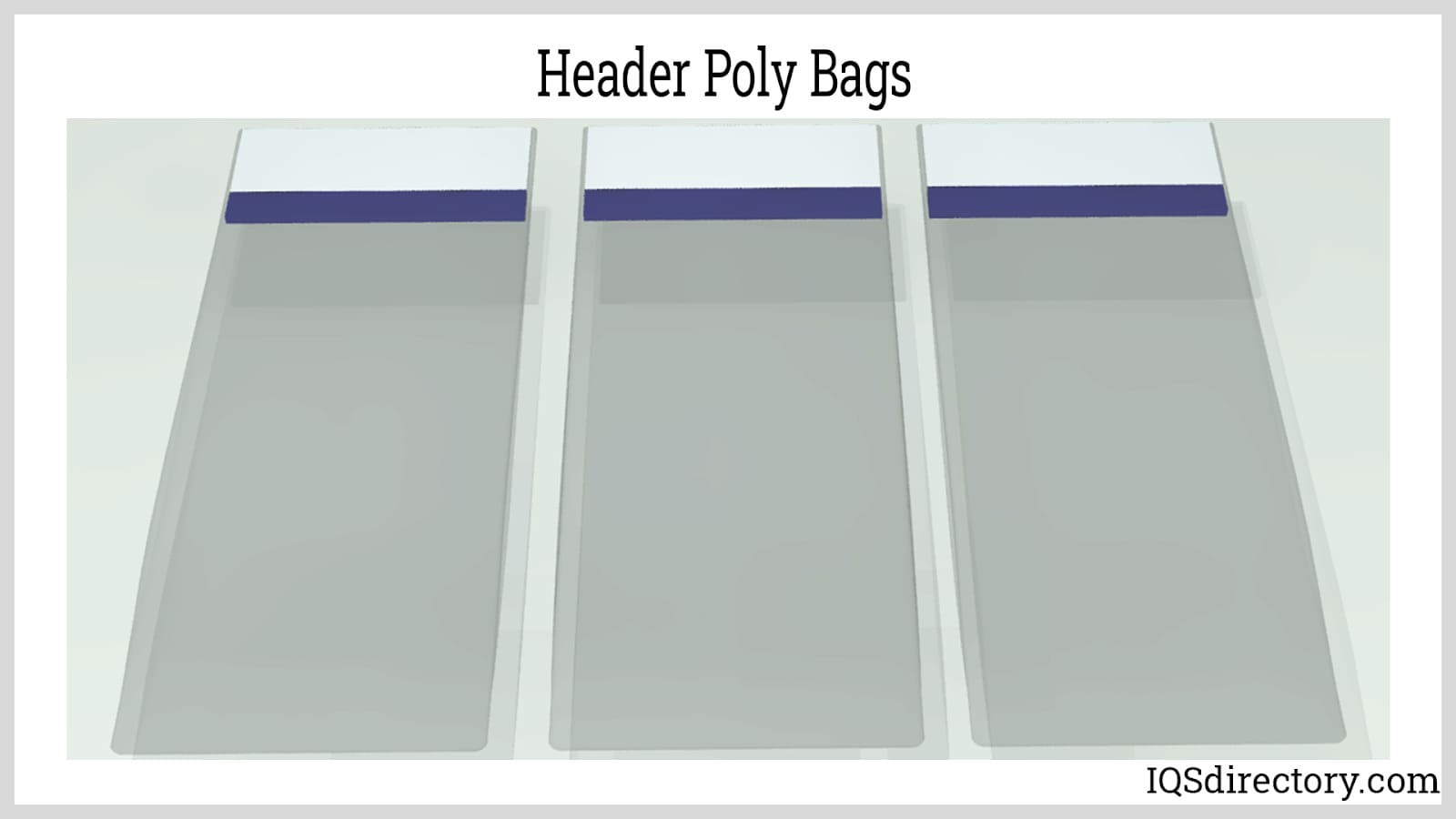
Drawstring Bags
There are innumerable uses for drawstring bags, which open and close by pulling on the cotton or poly string across the top of the bag. A common use for poly drawstring bags is carrying wet swimsuits or wet or soiled clothing to be washed. Since they are flexible and convenient, they can be folded and stored until they are needed. Most poly drawstring bags are gusseted to make them easier to open and fill.
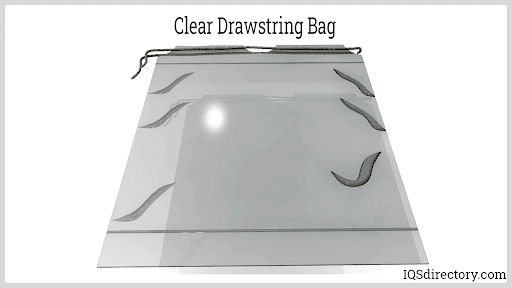
Chapter 4: Types of Poly Materials
The different types of poly materials allow producers to manufacture bags of varying thicknesses and endurance. Since the development of the first polymer over a hundred years ago, engineers and designers have continually developed new ways to combine the basic components to create stronger and more durable poly materials.
The different types of poly bags offer unique benefits and qualities that allow them to be adaptable to specific applications. The manufacture of poly bags includes the use of five types of plastic ideal for the production of plastic bags.
Types of Poly Materials
High Density Polyethylene (HDPE)
HDPE is the most used poly material for the manufacture of poly bags and is composed of a linear polymer with minimal branches. The chemical structure of HDPE is what creates its high density; HDPE is lightweight, sturdy, and nearly opaque. The resilience of HDPE gives it the ability to hold heavy loads without breaking. The image below is the recycling symbol for HDPE; it indicates the type of plastic and that it is easy to recycle.
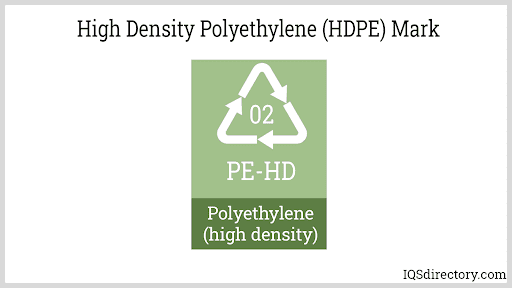
Low Density Polyethylene (LDPE)
LDPE is the polymerization of ethylene; it was completed in 1933 and found practical use in 1939. The polymer is short with branched chains resulting in a plastic film that is light weight with low tensile strength. It has a low melting point, making it ideal for bags to be heat sealed. LDPE is a type of polymer that is found in food packaging and coverings for clothes from dry cleaners.
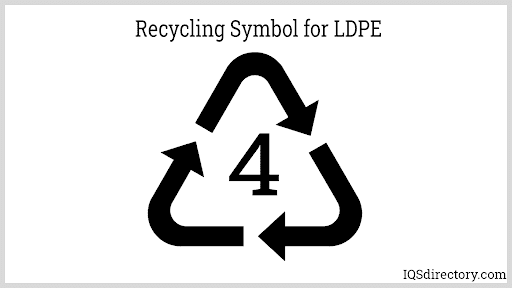
Linear Low Density Polyethylene (LLDPE)
LLDPE is a blended form of LDPE to make a more flexible, softer, and pliable plastic with greater tensile strength and formability. A unique feature of LLDPE is its ability to withstand heavy impact and stress without puncturing or tearing. Its molecules hold firmly together, which allows LLDPE to stretch. Common thicknesses for LLDPE are between 0.5 mil to 40 mil.
The gauge and clarity of LLDPE is lower than HDPE, but LLDPE has HDPE's strength. This makes LLDPE a cost effective replacement for LDPE.
Medium Density Polyethylene (MDPE)
MDPE was perfected to be a variation between HDPE and LDPE. The density of MDPE is not sufficient for the storage of bulk materials. It has low tolerance to chemical exposure and low tensile strength, but easily stretches. It is stronger than LDPE and has a tighter cell structure, which makes it more tear and puncture resistant than LDPE. Producers usually blend it with LLDPE or LDPE to create a stronger and more resilient material.
MDPE is produced using either a chromium-silica, Ziegler-Natta, or metallocene catalyst to give it shock and drop resistance. The unique properties of MDPE have made it useful for several types of poly bags.
Polypropylene (PP)
Polypropylene is a thermoplastic made from propylene monomers that was first introduced in 1951. It rapidly gained popularity as a material for the production of commercial products and is one of the most popular poly bag materials due to its resistance to chemicals and high melting point. The material of PP is non-breathable, which gives it a long shelf life and a safe means for storing food.
The popular use of polypropylene is also due to its ability to retain its shape after torsion, bending, and flexing. Its resistance to electricity makes it an ideal material for the storage of electrical components.
Recycled Plastic
With the rising concern for the environment and the bad name that has been given to poly bags, manufacturers have developed sophisticated methods to recycle plastic bags such that they can be used to produce new bags or other products. To remove contaminants and impurities, the bags are melted and dried to form the pellet-like material that is used in the extruding process.
To ensure purity, the pellets undergo a set of purification processes before being sent to the extruder for reprocessing. Manufacturers have perfected and improved this process such that any plastic bag can be used and reprocessed multiple times, creating substantial savings for the environment.
Chapter 5: How Poly Bags Are Recycled
The recycling of poly bags is a complicated process that is continually being perfected as the need to improve its efficiency and effectiveness continues to grow. Though not all types of poly bags can be recycled, many that are commonly used are chosen for that ability and purpose.
The key to recycling plastic bags, a practice manufacturers strongly support, is the proper disposal of them. As concern for the environment has grown, behaviors such as throwing plastic bags from a vehicle or leaving them at a campsite has drastically declined. Fines and penalties for improper disposal and awareness on part of the public has minimized the problem.
How Poly Bags Are Recycled
There are a variety of methods that producers use to recycle plastic bags. Each process is unique to the manufacturer and is customized to fit their operation. Regardless of the differences between processors, there are certain generic steps that are common to all.
Examination
When loads of plastic bags are received at recycling plants, they are examined for contaminants, impurities, volatile materials, items left in bags, and potentially dangerous or harmful substances. This is accomplished by loading the bags on a conveyor line where they are visually inspected or electronically inspected. Materials that do not meet the standards of the producer are removed and discarded.
Washing
The process of cleansing is continued by washing the bags in float tanks where magnets located over the tanks remove any metals and chemical solvents remove non-metallic and sticky substances. This aspect of the process not only serves the purpose of purifying the bags but also ensures the safety of workers.
The water used for the washing process never leaves the recycling plant but is cleaned, filtered, and reused. This method of water usage avoids the possibility of contaminants entering the water table or municipal water system.
Melting
Once it is assured that the poly bags have had harmful, contaminated, metal, volatile, or impure substances removed, the bags are melted to separate any possible hidden contaminates. The heating process is the final guarantee that all possible impurities have been removed and separated, leaving the base resin material.
Drying
During the melting process, more contaminants are removed, falling out as a form of goop or goo. As they pass through the melting process, the remaining material dries and solidifies into a plastic mass that has to be chopped up into pellets. At this point, there is further inspection for contaminants.
The dried pellets are sorted by size according to how they will be used. Larger pellets are sent back through the process to make them more useful.
Chopping
To gain consistency in the pellets, they are chopped into a fine snow like powder. The snowy material is further examined to ensure that it is the correct size for the next step of the process.
Extruding
The extruding process is the most technical part of the operation and must be closely monitored. At this point, all of the possible contaminants have been removed from the refined, melted, dried, and chopped flaky material. There is one substance that remains that could adversely affect the manufacturing process, which is water.
To ensure that any form of moisture or water has been completely removed, the flaky material goes through an extruder that is heated to 450° F. Any remaining extrusion is sieved out as well.
Formation of Resin
At the end of the extruding process, the melted material is cooled and dried. Much like the chopping that occurred after the first melting, the cleaned and clear resin is chopped into pellets and ready for the formation of new plastic poly bags.
The reprocessing and repurposing of used poly bags prevents them from littering the environment but also provides valuable raw material for the production of new plastic products, from grocery bags to newspaper bags. The cyclic nature of the process offers savings and conservation on several levels.
The complete process can be seen in the diagram below.
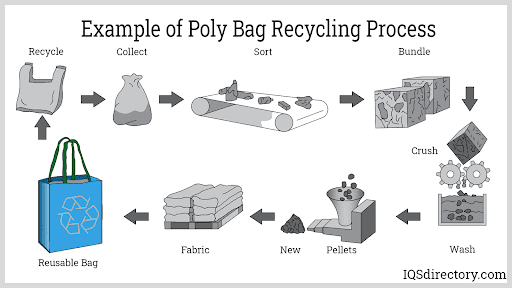
Chapter 6: Poly Bag Regulations and Standards
Due to the visibility and use of poly bags, there has been a great deal of attention focused on their use, disposal, and recycling. Regulations for poly bags have been adopted by individual states in the U.S., the United States Federal Government, and legislated international codes. All of the various restrictions are designed to control their environmental impact.
In addition to ecological regulations, standards have been established by the Federal Food and Drug Administration (FDA) and the United States Department of Agriculture (USDA). These organizations monitor materials and items that come into contact with the public such as food, medicines, medical instruments, and pharmaceutical products.
Poly Bag Regulations and Standards
Federal Drug and Food Administration (FDA)
The FDA standards are the same standards that are used by the United States Department of Agriculture (USDA). The standards for poly bags reference the raw materials used to produce the bags, which are required to be food grade. In this context, food grade refers to materials that have not been previously used and are not reprocessed.
The regulations further describe and identify the various types of polymer materials that are acceptable. The list encompasses hundreds of different bags with specific descriptions of requirements.
State Regulations
Individual states have legislated requirements for plastic bags, with three states and the District of Columbia having legislation forbidding their use. The control of poly bag distribution and use has also been legislated by individual municipalities and counties, as can be seen in the diagram below. The map also identifies the states and their status regarding Poly Bags.
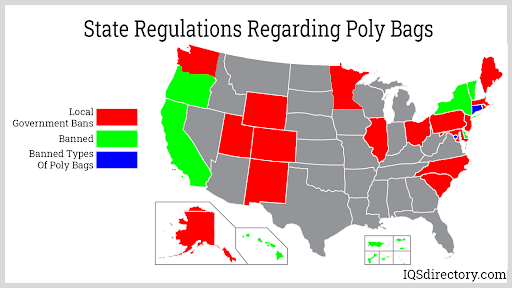
Internationally
European Union (EU) – The EU has several directives regarding poly bags and control of their use. The directives include 90/128/EEC, 92/39/EEC, 93/9/EEC, 95/3/EEC and 96/11/EC, Section A, to name a few. These regulations are in regard to the use of poly bags for storing and displaying food as well as bags that are permissible for medical use.
Great Britain – Great Britain has enacted legislation that is similar to that of the EU regarding what types of poly bags are permitted for use with food, pharmaceuticals, and medical equipment.
Though poly bags have been viewed negatively, much of the information regarding them is out of date. Present day producers work diligently to produce poly bags that meet the necessary environment and ecological standards. They are very aware of the impression poly bags have and work tirelessly to improve their products to ensure they are compliant.
Conclusion
- A poly bag is a common shipping and packaging resource made of polymer material that is exceptionally durable, pliable, and customizable to fit any application.
- Though polyethylene was introduced during the first industrial revolution, it wasn't until the 1950s that it was turned into the poly bags we see today.
- The production of poly bags involves highly technical and scientifically engineered processes that are precisely planned to ensure high quality results.
- The many options and designs for plastic bags has made them an essential part of society.
- The different types of poly materials allow producers to manufacture bags of varying thicknesses and endurance.
GET YOUR COMPANY LISTED BELOW
Leading Manufacturers and Suppliers
Quick Wrap Bags For Drawings
Source: https://www.iqsdirectory.com/articles/plastic-bag/poly-bags.html
Posted by: ungerherhumbrod.blogspot.com

0 Response to "Quick Wrap Bags For Drawings"
Post a Comment